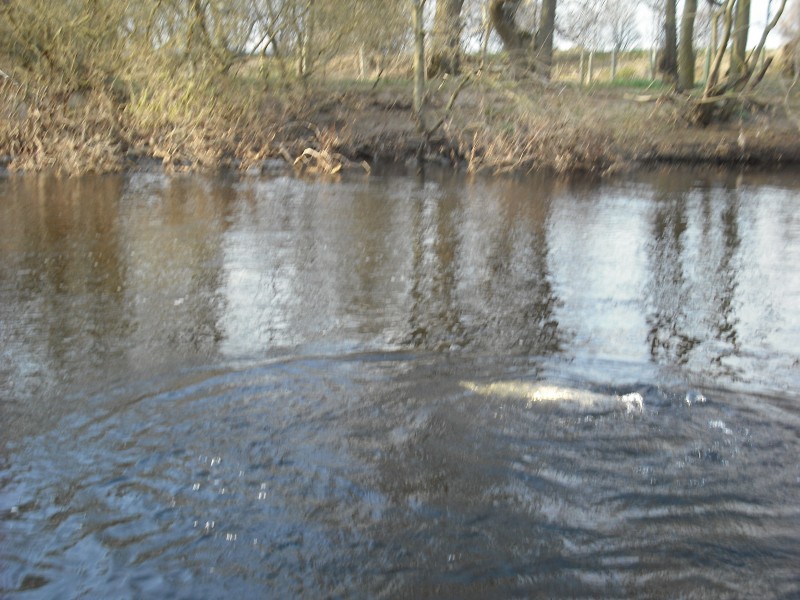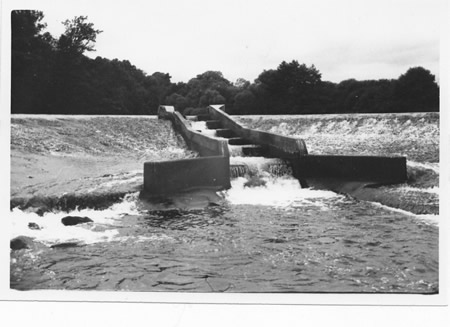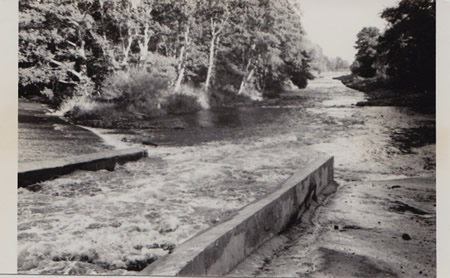These bulletin blogs represent news about Finavon and the South Esk, and my views as a riparian owner. They are not the views of any other organisation, nor are they designed to promote the interests of any individual or organisation other than Finavon Castle Water and factors affecting the fishery. Tony Andrews
Finavon Castle Water, River South Esk
Anyone talking about salmon these days simply has to take account of their unprecedented collapse in survival at sea before they start counting what they have caught in their wee patch. The truth is, and I cannot escape saying it, is that there are not enough salmon returning to our rivers to justify continuing to kill them as we did in the past. With that in mind anything that follows in these blogs about the performance of 2.4 miles of the middle South Esk during 2011 must be seen in the context of the overall decline in numbers of fish.
A March salmon of 15lbs (below) from the Willows on Milton Beat. Spring fish like this one are the ultimate quarry of the salmon fly fisherman.
In these out-of-season blogs I have attempted to show the local constraints to good numbers of salmon (and sea trout) accessing the river. The unpalatable fact is that the river is probably producing as many smolts as it did thirty years ago. There was far more exploitation by the nets then, and many more obstacles in the river. Finavon’s catches should therefore be seen as rods exploiting the remnants of far greater numbers of fish. The fact is that we are all catching fish from a diminishing stock of survivors, as are the coastal nets. 95% of our smolts are destined to die at sea. Multi sea winter salmon that feed in the Irminger Sea or off the Greenland coast are doing quite well, but those thin grilse – Belsen grilse – are scraping by on a meagre diet offered by their traditional feeding grounds in the northeast Atlantic Ocean. We can hope for change, but we shouldn’t bank on it. In the meantime we all need to be contributing to the maximum possible output of naturally generated smolts from our little river, because at the end of the day our river is a smolt factory!
In 2011 the number of fish entering the river between the 16th of February and the 31st of May was probably on a par with runs of fish in the 1960s and 1970s. A single year cannot of course tell the whole story, but what it does tell us is that in the late autumn of 2006 eggs were laid, probably by MSW fish. These spawning fish would have had a propensity to produce fish with a preference to return to the South Esk as multi sea winter spring fish. Moreover, they would have had to return in sufficient numbers to ensure recruitment of good numbers of juveniles, probably somewhere in the upper South Esk catchment. Over the two years following spawning the progeny of those fish grew to the point where in the spring of 2009 they left the river as S2 smolts and headed out to sea. After two winters at sea they returned to the South Esk in the early months of 2011.
At least something is right! For all the above to happen, quite a lot of things have to be right. If we assume that the survival rate of two sea winter fish from smolt to their return is about 5%, (but it could be better than that) then these survivors, from the abundance observed in the spring of 2011, indicate that a good number of S2 smolts left the South Esk in May/June 2008. That suggests that the habitat in certain (currently unknown) parts of the South Esk system is capable of meeting the requirements to produce healthy smolts with the potential of becoming spring salmon.
Do spring salmon beget spring salmon? Well, maybe! An interesting additional point is that, for there to have been sufficient spawners in 2006 to produce a good output of smolts in 2009, the spring run of 2001 MSW spring salmon (in which 10 were caught at Finavon) must have had sufficient successful spawners too. While we shouldn’t assume that a spring run spawner’s progeny is necessarily comprised of only spring fish, evidence points us towards that assumption. So, although we should not make general comments on the condition of stocks and the habitats that support them from one year’s return, it is clear that some cautious extrapolation can be done. What can be said with confidence is that the South Esk continues to have the characteristics (e.g. water chemistry, temperature and gradients) required by spring salmon. But what precisely are those characteristics, and where in the catchment are they?
Kinnaird dyke on 14th December 1969 (below) with the River at 3″ at Finavon. A much narrower and steeper access with no ‘pool’ at the base of the pass made it very difficult for fish to use in high or cold water. Donald Macintyre, the water bailiff, remarked that the rough concrete face of the dam damaged fish and made them prone to infection.
Kinnaird Dyke (below) on 29 September 1970 with the River at 1′ 4″ at Finavon. The repairs to the dyke that were done during 1970 made a big difference to enabling salmon to access the river above Brechin in the spring months. But it wasn’t until Colin Carnie in the mid nineties redesigned the dyke to reduce the flow through the pass with two wooden baffles which to this day enable salmon to swim through the pass early in the year. This is why we now see spring salmon at Finavon regularly in March month.
Spring 2011 salmon numbers: an educated guess? A calculation, based on the South Esk spring run of 2011 having a pre fishery abundance (PFA) of about 2,000 MSW salmon, representing 5% or more of the smolts that left the river, indicates that in 2009 the river produced up to 40,000 smolts with a preference to return as spring salmon. You may ask how I got the PFA figure of 2,000 spring fish. I can only answer that by claiming the number as a guess based on the declared Usan net catch, rod catches, the number of dead & diseased fish, and observation of fish in the pools in March, April and May. I note that no-one has yet challenged this estimated number of spring salmon.
It was clear to those who caught and released 2011 spring salmon that these survivors were in excellent condition & had fed well during their time at sea, suggesting that their marine feeding destination was probably in the productive western half of the ocean. It also begs the question, in the context of the poor grilse numbers in 2011, whether we might reasonably predict good returns of well fed MSW salmon in 2012, from grilse that elected to stay on for their second winter at sea and head west to feed. I suspect that may be a bridge too far in scientific terms, but a reasonable punt for an amateur such as myself! What it doesn’t explain is why, after a good grilse run in 2010, we had such a strong run of MSW salmon in the spring and summer of 2011. These are questions that scientists are now addressing, following the success in sampling salmon at sea done by the SALSEA project.
But what happened to the other c.95% of fish that didn’t survive? At what stage in their sea journey did they die, and from what cause?
So, while a snapshot can only be an indicator, and I certainly wouldn’t claim that it tells the whole story, a single year’s return as we had in 2011 does tell us something about the River’s ability to generate healthy populations of S2 smolts. Wouldn’t it be interesting to learn which parts of the South Esk catchment have this ability? That is why I like the Marine Scotland Science plan to track the destination of 150 spring salmon. It would be so good to learn which bits are productive, and why they are, wouldn’t it? And, just think, if we could find out where the juveniles grow well, wouldn’t we then become much more precise in our habitat improvement work?
The next blog gives the catch statistics with comments from people who have managed the river, owned beats or fished the South Esk over more than a century


